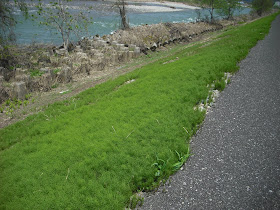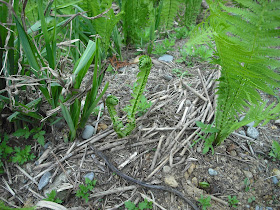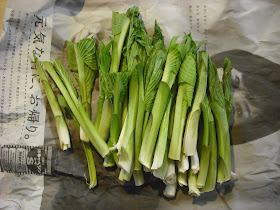Last Monday, I took these photos on my way to my rented farm land. The good news for me is that the road to the farm land is now paved with asphalt!
この前の月曜、借りている農地に行く途中で写真を撮りました。
私にとっていいニュースは、農地に行く道がアスファルトで舗装されたことです!

You can see various types of sansai on both sides of the road.
Yomogi (mochi gusa) or mugwort:
蓬(よもぎ)、餅草(もちぐさ):

Itadori (Japanese knotweed):
イタドリ:

You can see some bracken fern sprouts around the center of the photo.
写真の中央あたりには蕨(わらび、ワラビ)も幾つか見えます。
Itadori comes from ita (< itami = pain) + dori (< toru = to take away, to remove, etc.)
イタドリの語源は「イタ」(痛み)+ドリ(「取る」)です。
Carpet of sugina (fertile stems of field horsetail):
杉菜(スギナ)のカーペット:

Sugina comes from sugi (Japanese cedar) + na (green, vegetable).
杉菜(スギナ)の語源は「杉」+「菜」です。
Sugina and tsukushi (sterile stems of field horsetail):
スギナと土筆(つくし、ツクシ):

Tsukushi is written as two kanji soil (土) and ink brush (筆).
ツクシは漢字では二文字「土」「筆」と書きます。
Fuki (butterbur stalks):
蕗(ふき):

Don't confuse fuki (butterbur stalks) with fukinoto (butterbur flower stalks).
蕗と蕗の薹(ふきのとう)、つまり蕗の花茎を混同しないで下さい。
Reddish knotweed:
赤っぽいイタドリ:

Kogomi (or kogome), young shoots of ostrich fern (fiddleheads):
こごみ(こごみ):

As I said in the preceding post, kogomi is so called because it looks as if it were bending down (kagamu in Japanese).
前に述べたように、こごみは、かがんでいるように見えるので、その名がつきました。
Almost all others were already fully open.
他のは殆ど全て開き切っていました。

There were more of them near the river.
川の近くにもっとありました。

I found more itadori. They were much taller.
イタドリはもっとありました。背が高かったです。


Today, I got two sansai from a sister-in-law.
今日は義理の姉から山菜を二種類もらいました。
Kogomi (fiddleheads):
こごみ:

Urui:
ウルイ:

More about urui in a future post.
ウルイについてはまた後で述べます。
Thank you for the trip. Even the roadside in Japan looks exotic to a European!
ReplyDeleteI appreciate a lot your linguistic explanation. And maybe, just accidentally I will remember the kanji for soil... Since as you say the Japanese love wild plants, do they all know wild plants as well as you do?
(Wasn't the knot weed the one you made soft drink with last year?).
I'm looking forward to seeing your farm land this year.
I, too, appreciate a lot to your linguistic explanation. I really enjoy knowing about it. Thank you so much. As for the wild plants, you can just pick them! Sounds like a lot of fun! I am curious about your rental farm land, how big is it and how often do you attend to it? What is the rental rate for the season? It is common for city folks with lack of land in urban area. We have the convenience of growing things in our own back yard. However, the people that live in downtown high rises have 'communal garden'. The City have a designated area within downtown that people can share and use.
ReplyDeleteVery interesting and not really that exotic if we think about the distances. We have the same or nearly the same plants:
ReplyDeleteMost of the time you will find lots of horsetail (lat. Equisetum arvense, maybe L.) here growing in very poor soil or in meadows (different varieties). I am not quite sure if there are any mayor differences between japanese horsetail and our varieties. There is a small difference between our mugwort (Artemisia vulgaris) and the japanese variety (Artemisia princeps) referenced by some garden books - at least the taste may not be the same. Our mugwort has a slightly bitter taste - the older the plant the bitter - but we use it as dried spice herb too. The young plants do look the same.
Knotweed - I am looking for some patches to pick some to make the jelly.
And what you call Butterbur is called Huflattich in german (lat. Tussilago farfara) in english coltsfoot, in former times used as cold medicine - the cough sirupe tasted delicious.
As for ostrich fern - we have it too, growing in the wild, but the patches are rare if you don't know were to find it. Bracken is much more common and easy to be found.
I should try and make a field trip too to show you our edible wild greens.
Sissi:
ReplyDelete> do they all know wild plants as well as you do?
Yes, almost all of the people around here know these sansai, except itadori. Itadori is not relished as a sansai here in Niigata. It's very popular in Kochi 高知.
I knew little about sansai before I came here, and I have learned a lot about them since I came here. I think that most of the people in urban areas are like me. (They like to eat sansai, but they know little about them.)
I tried to make itadori drink, but gave up at the last moment!
okasan: It's fun, but be careful! Some wild plants are toxic and others are even fatal!
ReplyDeleteMy patch is about 5 m x 6 m (16 ft x 20 ft). No rental rate. I borrow it for free from a friend. I give her a gift worth around 3,000 yen every year, though.
You may think that such a small patch is nothing, but it's big enough for me.
Kiki: Thank you very much for your very detailed information!
ReplyDeleteYoung leaves of yomogi are picked up around this time of year (in the spring) for use in wagashi. I, for one, like to have young leaves as tempura. Yomogi tempura is much better than shiso (green perilla) tempura, in my opinion.
I encourage you to make itadori jam and drink!
okasan: Sorry, I haven't answer one of your questions.
ReplyDeleteI would like to attend to it every other day or every two days, but in reality, I can only attend to it about once a week. The owner of the much bigger farm land, next to mine, says he comes three times a DAY!
Hiroyuki-san,
ReplyDeleteI have a question for you. I was looking at the picture under this notation:
"There were more of them near the river.
川の近くにもっとありました。"
There are concrete looking mounds in the pictures with numbers marked on them. Do you know what these are?
muskratbyte: Tetrapods, I suppose.
ReplyDeleteHi,
ReplyDeleteMay I use your picture of urui for an article in the Swedish garden magazine Natur&Tradgard?
Best regards
Lotta Floden
Managing Director
Natur&Tradgard
www.naturochtradgard.se
Lotta Floden: Of course, be my guest!
ReplyDeleteThank you so much!
ReplyDeleteHappy regards
Lotta